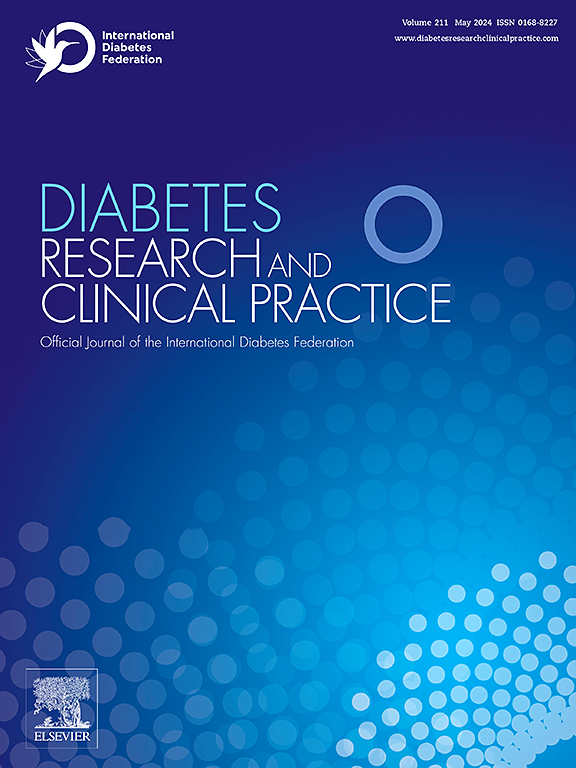Associations of triglyceride–glucose index cumulative exposure and variability with the transitions from normoglycaemia to prediabetes and prediabetes to diabetes: Insights from a cohort study
IF 6.1
3区 医学
Q1 ENDOCRINOLOGY & METABOLISM
引用次数: 0
Abstract
Aim
This study aimed to investigate the separate and joint associations of triglyceride–glucose (TyG) index accumulation and variability with prediabetes and diabetes risk.
Methods
Health check-up participants who underwent 3 sequential health examinations during 2012–2016 and were followed up from 2017 to 2021 were enrolled and categorized into two subcohorts: (a) progression from normoglycaemia to prediabetes subcohort (n = 9373) and (b) progression from prediabetes to diabetes subcohort (n = 4563). Cumulative TyG (cumTyG) and TyG variability from Exams 1–3 were the exposures of interest in our study. The outcomes were newly incident prediabetes or diabetes.
Results
In the prediabetes development subcohort, 2,074 participants developed prediabetes over a 2.42-year follow-up. Higher cumTyG (HR, 2.02; 95 % CI, 1.70–2.41), but not greater TyG variability alone, was significantly associated with increased prediabetes risk. In the diabetes development subcohort, 379 participants developed diabetes over a 3.0-year follow-up. Higher cumTyG (HR, 3.54; 95 % CI, 2.29–5.46), but not greater TyG variability alone, was significantly associated with increased diabetes risk. The “cumTyG+variability” combination had the highest predictive value for prediabetes and diabetes beyond a single baseline TyG measurement.
Conclusion
Higher cumTyG exposure independently predicts prediabetes and diabetes incidence. Coexisting cumTyG and variability could further yield incrementally greater risks.
甘油三酯-葡萄糖指数累积暴露量和变异性与正常血糖向糖尿病前期和糖尿病前期向糖尿病转变的关系:一项队列研究的启示
目的 本研究旨在探讨甘油三酯-葡萄糖(TyG)指数累积和变异与糖尿病前期和糖尿病风险的单独和联合关联。方法 对在 2012-2016 年期间接受了 3 次连续健康检查,并在 2017 年至 2021 年期间接受随访的体检参与者进行登记,并将其分为两个亚队列:(a) 从血糖正常发展到糖尿病前期亚组(n = 9373)和 (b) 从糖尿病前期发展到糖尿病亚组(n = 4563)。累积 TyG(cumTyG)和第 1-3 次检查的 TyG 变异是我们研究中关注的暴露。结果在糖尿病前期发展亚队列中,有2074名参与者在2.42年的随访期间患上了糖尿病前期。较高的累积TyG(HR,2.02;95 % CI,1.70-2.41)与糖尿病前期风险的增加有显著相关性,而非仅仅与较高的TyG变异性有显著相关性。在糖尿病发展亚队列中,379名参与者在3.0年的随访期间患上了糖尿病。较高的 cumTyG(HR,3.54;95 % CI,2.29-5.46)与糖尿病风险的增加有显著相关性,但与单独较高的 TyG 变异性无关。结论较高的累积TyG暴露可独立预测糖尿病前期和糖尿病的发病率。结论较高的累积TyG暴露可独立预测糖尿病和糖尿病的发病率,同时存在的累积TyG和变异性可进一步增加风险。
本文章由计算机程序翻译,如有差异,请以英文原文为准。
求助全文
约1分钟内获得全文
求助全文
来源期刊

Diabetes research and clinical practice
医学-内分泌学与代谢
CiteScore
10.30
自引率
3.90%
发文量
862
审稿时长
32 days
期刊介绍:
Diabetes Research and Clinical Practice is an international journal for health-care providers and clinically oriented researchers that publishes high-quality original research articles and expert reviews in diabetes and related areas. The role of the journal is to provide a venue for dissemination of knowledge and discussion of topics related to diabetes clinical research and patient care. Topics of focus include translational science, genetics, immunology, nutrition, psychosocial research, epidemiology, prevention, socio-economic research, complications, new treatments, technologies and therapy.
 求助内容:
求助内容: 应助结果提醒方式:
应助结果提醒方式:


